Wall Mounted vs Floor Mounted Toilets
Be it you are looking around for a new toilet to replace an old one or just for a fresh installation, one of the most important questions to ask is what style or shape suits your bathroom best. Wall-hung and floor-mounted toilets are among the most common designs you’re likely to encounter. While they serve the same purpose, these two styles are distinct in many aspects.
Wall-mounted toilets are a modern toilet design that attaches to the wall, with no part of the toilet touching the floor, and have their tank installed inside the wall while floor-mounted toilets are a traditional toilet design that connects to the floor with a clearly visible tank and a protruding bowl.
What style of mount you’ll choose depends on many factors, including your bathroom space, budget, theme/style, ergonomics, and maintenance, among other factors. Following is a detailed comparison guide to help you make the right decision.
The Differences
The table below highlights the fundamental differences between floor-mounted and wall-mounted toilet styles.
| Wall-mounted Toilet | Floor-mounted Toilet | |
| Other Names | Wall-hung, floating, and in-wall | Floor-standing, classic, regular, traditional, or standard toilet |
| Mounting | Attached to the wall | Attached to the floor |
| Tank/Cistern | Invisible | Visible |
| Cost | Expensive | Relatively affordable |
| Installation | Relatively hard | Easy to install |
| Height | Adjustable | Fixed |
| Stability | Becomes less stable over time | More stable |
| Cleaning | Easier to clean | Harder to clean |
| Theme | Modern & minimalism | Traditional & maximalism |
| Bathroom size | Ideal for compact/small bathroom | Ideal for spacious bathrooms. |
| Aesthetics | Stylish, sleekier, and contemporary | Less pretty, bulky, and old-fashioned |
| Repair and Maintenance | Complicated | Relatively simple |
| Users | Elderly, disabled, tall and short | Limited to a single-user group |
| Noise | Makes less noise from flushing and refilling | Most make a lot of noise when flushing and refilling |
Mount Location
As their names suggest, the first and most outstanding difference comes from where the toilet is mounted or the surface to which the toilet bowl is attached to.
Wall-mounted toilets are mounted on the toilet wall and provide the sense of floating, as they are suspended above the floor.
Floor-mounted toilets, on the other hand, have a base that is fixed to the bathroom floor. The bowl sits directly on the floor leaving no space between the base and the floor.
Appearance & Parts
A wall-hung toilet has a hidden tank that is built into the wall cavity, a bowl that sticks out, and a visible flush actuator/handle that is placed on the surface of the wall just above the bowl. Another key part of a wall-hung toilet is the carrier, the part to which the bowl is anchored and provides enough support to carry the tank. Other wall-hung toilets come with additional parts that allow you to access the concealed tank without having to dismantle the wall.
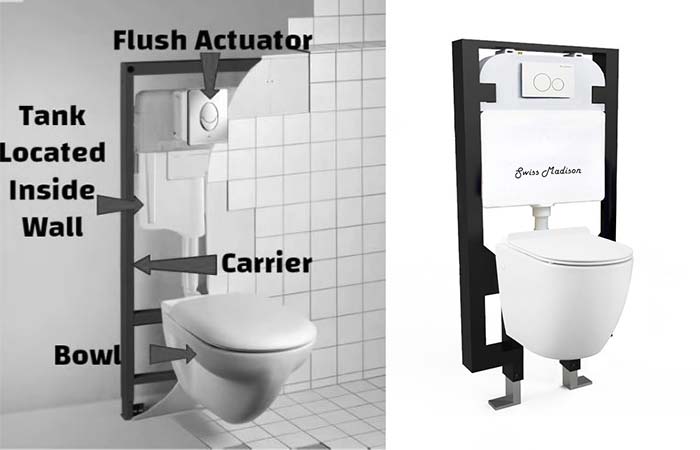
The Standard floor-mounted toilet has the classic bowl-and-tank configuration, with both the tank and bowl visible.
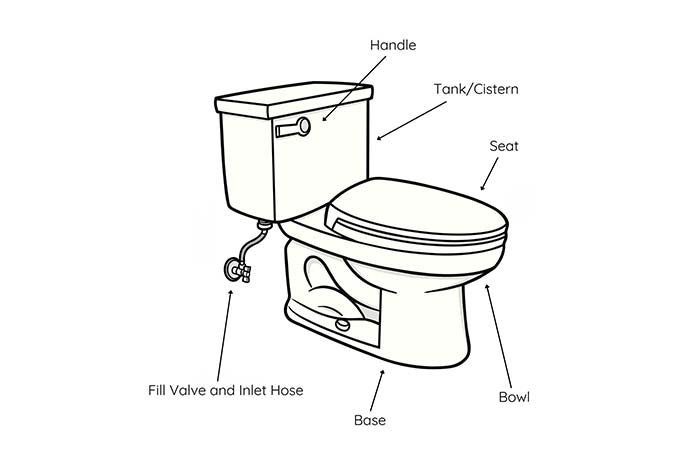
However, there are floor-mounted toilet types that come without a tank and with additional parts. These include premium tankless, smart toilets which come with modern designs and advanced technologies.
Installation Procedure
Overall, installing a wall-hung is not only involves sophisticated plumbing procedures but also costly.
This is primarily because the tank and supporting system (carrier ) have to be installed into the wall. The existing wall of your bathroom has to be partially removed or modified.
Further Reading: Common Wall-hung Toilet Problems
In some cases, especially when your bathroom wall is too thin, an extra wall, known as a ledge wall, may be required to add more thickness for reinforcement. In most cases, you need an experienced plumber to do the installation.
It is best to install before tiling, cannot be an afterthought unless you have the money to spend in redesigning your bathroom.
On the other hand, installing a standard floor-mounted toilet is much easier and you do not need a lot of modifications. With the help of a manual guide, most people can do it on their own.
All you need is to assemble and attach the tank to the bowl, fix the bowl to the floor, connect the toilet outlet to the sewer and finally connect the tank to the water supply.
Space Requirements
While both floor and wall-mounted toilets are nearly similar in size, wall-hungs, because the carrier and the tank are installed into the wall, leave more space making the room bigger. This frees up more room to install other items or appliances, like sinks and towel racks. They are ideal for compact bathrooms.
With a wall-hung toilet, you can save up to 10 inches compared to a floor-mounted model simply by having the tank in the wall. Besides that, you can also position the bowl at various heights, anywhere from 15 to 19 inches off the ground, freeing up more space underneath the bowl.
Floor-mounted toilets on the hand take up more space due to the exposed tank and protruding bowl that is fixed to the floor. This setup makes a small bathroom appear even more cramped.
They are ideal for bathrooms with plenty of space. In particularly tight bathrooms, regular floor-mounted toilets can be difficult to install in a way that meets building code clearance requirements.
Cost
Cost encompasses the amount you will need to buy (all the components), install and maintain/repair the toilet in the long term.
The cost of a wall-hung is significantly high. The price can range from $500 to $2,000 or more.
The purchase price is usually high than standard toilets. Besides, the cistern and bowl are not, in most cases, sold as a single package, which raises the price. Another aspect that makes wall-hung toilets costly is installation. As mentioned earlier, this task is quite complex, and it requires an experienced plumber.
In terms of maintenance and repair, wall-mounted are still expensive since you will need an expert to fix it. Since they’re not as common as the traditional toilets, parts are a bit pricy and not readily available.
Standard floor-mounted toilets are generally cheaper in terms of acquisition, installation and maintenance. They can cost $100 to $450. You can easily install them on your own or higher a plumber at a pocket-friendly fee. Parts for repair are readily available and cheap.
It is important to note that not all floor-mounted toilets are cheap, there are premium floor-mounted toilets such as the TOTO Neorest series that are quite expensive
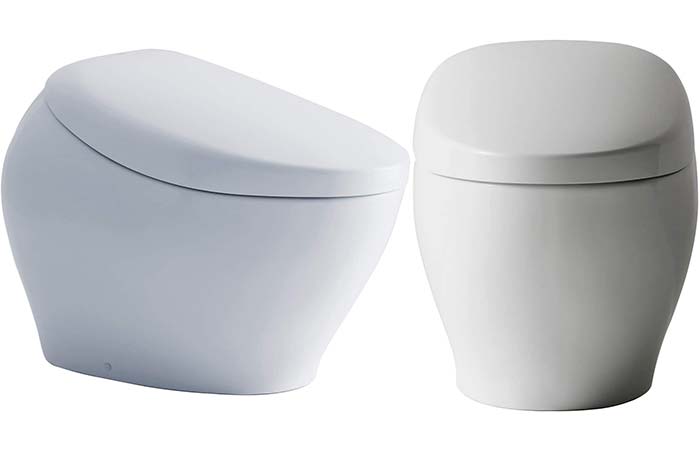
Aesthetics
It is quite obvious that wall-mounted toilets are more aesthetically pleasing than floor-mounted toilets.
The fact that the water tank is hidden gives the bathroom a peaceful and soothing feel, as opposed to the latter, where all fixtures are visible. The exposed features of floor-mounted toilets are sometimes deemed unsightly.
A wall-hung toilet is an excellent alternative for a minimalist and contemporary designer style. However, many one-pieces and tankless floor-mounted toilets feature elegant designs as well..
Cleaning
Wall-mounted toilets are much easier to clean than floor-mounted toilets. Because they aren’t linked to the floor, you may easily use the mop to clean that area without bending down. Cleaning the space around them is also a breeze because of the basic designs and the fact that, aside from the bowl, everything else is concealed.
Floor mounted toilets are more difficult to clean because the majority of the features are exposed to debris, which can become trapped within the different joints.
Maintenance
Standard floor mounted toilets are easier to maintain and repair because you can instantly open the non-concealed tank and access the fittings for adjustments or replacement with new ones.
Maintaining and repairing wall-mounted toilets, on the other hand, is tough because most of the parts are difficult to access.
Although some wall-mounted toilets provide an access panel on the wall for easy repairs, not all of them do, and if repairs are required, the wall must be disassembled and then reassembled.
Durability & Stability
Since floor-mounted toilets are fixed to the floor, their parts do not encounter as much tensional stress. If properly installed and used, they’re usually more stable and will last longer.
Wall-hungs tend to be less stable because of the floating effect. The parts that anchor wall-hung bowl to the wall encounter quite a lot of tensional stress leading to wear and tear that eventually result in loosening.
It is important to ensure that your wall-hung toilet is properly installed. You can also have a professional plumber check and adjust the commode once in a while.
Height
Different users require different toilet seat heights. While wall-hung toilets’ height can be adjusted to fit almost any user’s height, floor-mounted varieties come in a fixed height.
Wall-hung toilets can be installed at a variety of heights, from 15 to 19 inches above the floor. This means short, tall, disabled and elderly people can adjust to a height that suits them.
A floor-mounted toilet cannot be adjusted because of its shape and design, thus you must accept the fixed height of your chosen model. However, you can still use additional accessories to raise to increase the height either from the base or seat level. You can also buy a tall floor-mounted toilet.
Noise
Standard floor-mounted toilets usually produce a lot of noise during flushing and refilling since all the flushing parts are not concealed. While there are high-end models that are created to be quiet, most traditional toilets are noisy.
Wall-hungs, on the other hand, tend to be quieter because the tank is inside the wall. The sound of refilling after each flush is insignificant.
Floor-mounted vs Wall-hung Toilets-Which is Better?
Floor-mounted toilets are a better choice in the long run because they’re cheap, readily available and easy to install and maintain.
On the other hand, wall-hung toilets are a good idea if you have a small bathroom and prefer a design that is modern and minimalistic. While floor-mounted toilets have been the norm, wall-mounted toilets are a real alternative to consider.
Overall, what type of mount you choose will depend on your budget, bathroom space and theme, your preferred style/design.
Top Floor and Wall Mount Toilet Models
Some of the best and most reviewed floor and wall-mounted toilets include the following.
WOODBRIDGE T-0019 One-Piece Floor-Mounted Toilet
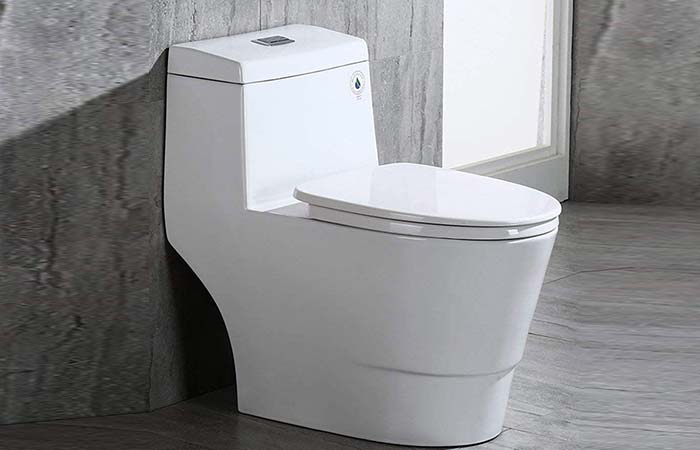
This is a luxurious one-piece toilet that features a clean and sleek design that can go well with different themes, be it traditional or modern.
It is incredibly easy to clean and it features a comfort height design, with a powerful yet quiet flush system
TOTO Drake (CST744SL) Floor-mounted 2PC Toilet
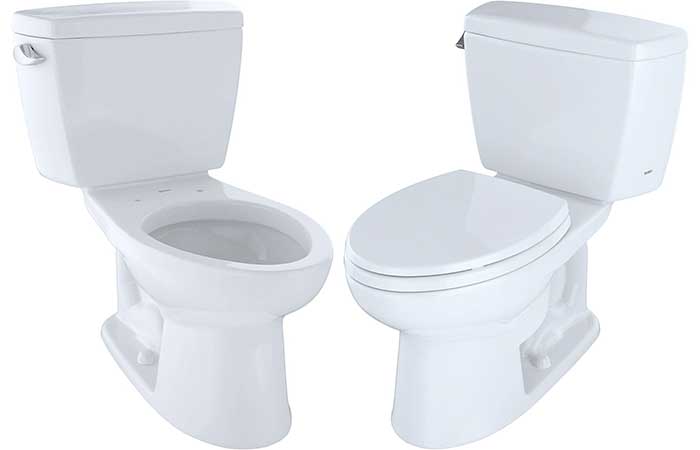
This is a two-piece toilet with an elongated bowl design that features G-Max flushing system which is quiet and powerful, low consumption (1.6GPF/6.0LPF),
Swiss Madison Well Made Forever SM-WT450MB, Ivy Wall Hung Elongated Toilet.
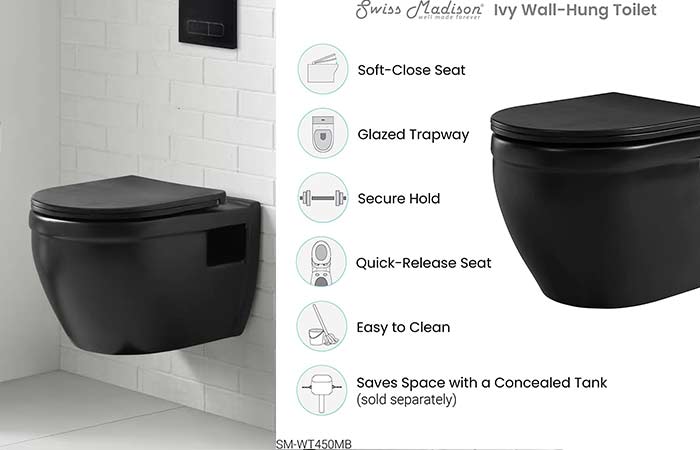
It is one of the most affordable products out there. It features a dual flush system with high-performance gravity 0.8 / 1.28 gallon per flush. It is compatible with all Carrier brands.
KOHLER K-6299-0 Veil Wall-Hung Elongated Toilet Bowl
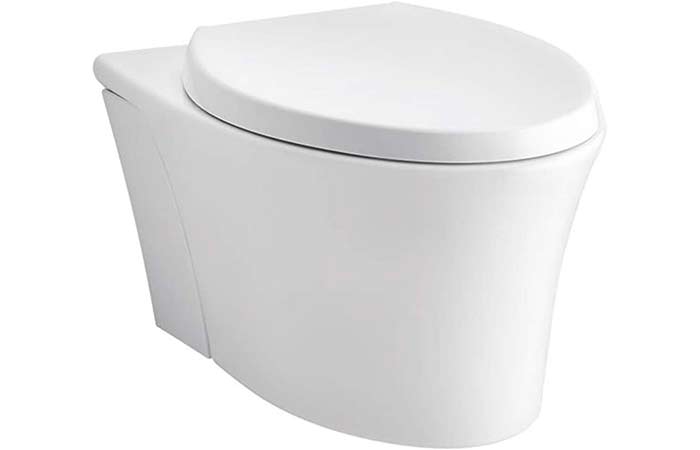
This piece includes a wall-hung bowl with a Grip Tight Reveal Q3 seat. It also combines with the K-6284 In-Wall Tank and Carrier System to create a complete K-6303 Veil toilet.